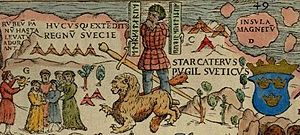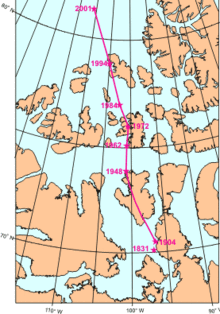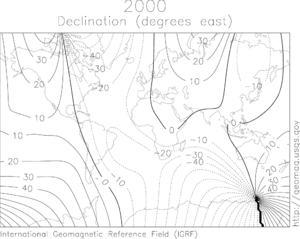- North Magnetic Pole
-
"Magnetic North" redirects here, for other uses see Magnetic North (disambiguation)
 Part of the Carta Marina of 1539 by Olaus Magnus, depicting the location of magnetic north vaguely conceived as "Insula Magnetu[m]" (Latin for "Island of Magnets") off modern day Murmansk. The man holding the rune staffs is the Norse hero Starkad.
Part of the Carta Marina of 1539 by Olaus Magnus, depicting the location of magnetic north vaguely conceived as "Insula Magnetu[m]" (Latin for "Island of Magnets") off modern day Murmansk. The man holding the rune staffs is the Norse hero Starkad.
The Earth's North Magnetic Pole is the point on the surface of the Northern Hemisphere at which the Earth's magnetic field points vertically downwards (i.e., the "dip" is 90°). Though geographically in the north, it is, by the direction of the magnetic field lines, physically the south pole of the Earth's magnetic field. The North Magnetic Pole should not be confused with the Geographic North Pole, nor with the lesser known North Geomagnetic Pole described later in this article.
The North Magnetic Pole moves slowly over time due to magnetic changes in the Earth's core. In 2001, it was determined by the Geological Survey of Canada to lie near Ellesmere Island in northern Canada at 81°18′N 110°48′W / 81.3°N 110.8°W. It was estimated to be at 82°42′N 114°24′W / 82.7°N 114.4°W in 2005. In 2009, it was moving toward Russia at between 34 and 37 mi (55-60 km) per year.[1]
Its southern hemisphere counterpart is the South Magnetic Pole. Because the Earth's magnetic field is not exactly symmetrical, the North and South Magnetic Poles are not antipodal: a line drawn from one to the other does not pass through the geometric centre of the Earth.
The Earth's North and South Magnetic Poles are also known as Magnetic Dip Poles, with reference to the vertical "dip" of the magnetic field lines at those points.
Contents
Polarity
All magnets have two poles that are distinguished by the direction of the magnetic flux. In principle these poles could be named in any way; for example, as "+" and "−", or "A" and "B". However, based on the early use of magnets in compasses they were named the "north pole" (or more explicitly "north-seeking pole"), "N", and the "south pole" (or "south-seeking pole"), "S", with the north pole being the pole that pointed north (i.e. the one attracted to the Earth's North Magnetic Pole). Because opposite poles attract, the Earth's North Magnetic Pole is therefore, by this definition, physically a magnetic field south pole.[2][3][4] Conversely, the Earth's South Magnetic Pole is physically a magnetic field north pole.
History
In early times European navigators believed that compass needles were attracted either to a "magnetic mountain" or "magnetic island" somewhere in the far north (see Rupes Nigra), or to the Pole Star.[5][6] The idea that the Earth itself acts as a giant magnet was first proposed in 1600 by the English physician and natural philosopher William Gilbert. He was also the first to define the North Magnetic Pole as the point where the Earth's magnetic field points vertically downwards. This is the definition used nowadays, though it would be several hundred years before the nature of the Earth's magnetic field was understood properly.[5]
Expeditions and measurements
See also: Arctic exploration, Farthest North, and List of Arctic expeditionsEarly
The first expedition to reach the North Magnetic Pole was led by James Clark Ross, who found it at Cape Adelaide on the Boothia Peninsula on June 1, 1831. Roald Amundsen found the North Magnetic Pole in a slightly different location in 1903. The third observation was by Canadian government scientists Paul Serson and Jack Clark, of the Dominion Astrophysical Observatory, who found the pole at Allen Lake on Prince of Wales Island in 1947.[7]
Modern (post 1996)
The Canadian government has made several measurements since, which show that the North Magnetic Pole is moving continually northwestward. In 1996 an expedition certified its location by magnetometer and theodolite at 78°35.7′N 104°11.9′W / 78.595°N 104.1983°W.[8] Its estimated 2005 position was 82°42′N 114°24′W / 82.7°N 114.4°W, to the west of Ellesmere Island in Canada.[9] During the 20th century it moved 1100 km, and since 1970 its rate of motion has accelerated from 9 km/year to approximately 41 km/year, or 1.3 mm/sec (2001–2003 average; see also Polar drift). If it maintained its present speed and direction it would reach Siberia in about 50 years, but it is expected to veer from its present course and slow its rate of motion.[citation needed]
This general movement is in addition to a daily or diurnal variation in which the North Magnetic Pole describes a rough ellipse, with a maximum deviation of 80 km from its mean position.[10] This effect is due to disturbances of the geomagnetic field by charged particles from the Sun.
North Magnetic Pole [9] (2001) 81°18′N 110°48′W / 81.3°N 110.8°W (2004 est) 82°18′N 113°24′W / 82.3°N 113.4°W (2005 est) 82°42′N 114°24′W / 82.7°N 114.4°W South Magnetic Pole [11] (1998) 64°36′S 138°30′E / 64.6°S 138.5°E. (2004 est) 63°30′S 138°00′E / 63.5°S 138.0°E The first team of novices to reach the Magnetic North Pole did so in 1996, led by David Hempleman-Adams. It included the first British woman and first Swedish woman to reach the Pole. The team also successfully tracked the location of the Magnetic North Pole on behalf of the University of Ottawa.
The biennial Polar Race takes place between Resolute Bay in northern Canada and the 1996-certified location of the North Magnetic Pole at 78°35.7′N 104°11.9′W / 78.595°N 104.1983°W. On 25 July 2007, the Top Gear Polar Challenge Special was broadcast on BBC Two in the United Kingdom, in which Jeremy Clarkson and James May became the first people in history to reach this location in a car.[12]
Magnetic north and magnetic declination
Main article: Magnetic declinationSee also: Earth's magnetic fieldThe direction in which a compass needle points is known as magnetic north. In general, this is not exactly the direction of the North Magnetic Pole (or of any other consistent location). Instead, the compass aligns itself to the local geomagnetic field, which varies in a complex manner over the Earth's surface, as well as over time. The angular difference between magnetic north and true north (defined in reference to the Geographic North Pole), at any particular location on the Earth's surface, is called the magnetic declination. Most map coordinate systems are based on true north, and magnetic declination is often shown on map legends so that the direction of true north can be determined from north as indicated by a compass.
Magnetic declination has been measured in many countries, including the U.S. The line of zero declination (the agonic line) in the U.S. runs from the North Magnetic Pole through Lake Superior and southward into the Gulf of Mexico. Along this line, true north is the same as magnetic north. West of the line of zero declination, a compass will give a reading that is east of true north. Conversely, east of the line of zero declination, a compass reading will be west of true north.
Magnetic declination is still very important for certain types of navigation that have traditionally made much use of magnetic compasses; see the main article (Magnetic declination) for details.
North Geomagnetic Pole
Main article: Geomagnetic poleAs a first-order approximation, the Earth's magnetic field can be modelled as a simple dipole (like a bar magnet), tilted about 11° with respect to the Earth's rotation axis (which defines the Geographic North and Geographic South Poles) and centred at the Earth's centre. The North and South Geomagnetic Poles are the antipodal points where the axis of this theoretical dipole intersects the Earth's surface. If the Earth's magnetic field were a perfect dipole then the field lines would be vertical at the Geomagnetic Poles, and they would coincide with the Magnetic Poles. However, the approximation is imperfect, and so the Magnetic and Geomagnetic Poles lie some distance apart.
Like the North Magnetic Pole, the North Geomagnetic Pole attracts the north pole of a bar magnet and so is in a physical sense actually a south magnetic pole. It is the centre of the region of the magnetosphere in which the Aurora Borealis can be seen. As of 2005 it was located at approximately 79°44′N 71°47′W / 79.74°N 71.78°W, off the northwest coast of Greenland,[13] but it is now drifting away from North America and toward Siberia.
Geomagnetic reversal
Main article: Geomagnetic reversalOver the life of the Earth, the orientation of Earth's magnetic field has reversed several times, with magnetic north becoming magnetic south and vice versa – an event known as a geomagnetic reversal. Evidence of geomagnetic reversals can be seen at mid-ocean ridges where tectonic plates move apart and the seabed is filled in with magma. As the magma seeps out of the mantle the magnetic particles contained within it are oriented in the direction of the magnetic field at the time the magma cools and solidifies.
See also
References
- ^ North Magnetic Pole Moving East Due to Core Flux, National Geographic, December 24, 2009
- ^ http://www.kjmagnetics.com/glossary.asp K&J Magnetics, glossary
- ^ Definition of north pole (of a magnet) at Merriam-Webster's Online Dictionary
- ^ Earth's Magnetic Poles, Randy Russell, University Corporation for Atmospheric Research website
- ^ a b Early Concept of the North Magnetic Pole, Natural Resources Canada, retrieved June 2007
- ^ The Geodynamo, D R Fearn, University of Glasgow, August 19, 2004
- ^ History of Expeditions to the North Magnetic Pole, Natural Resources Canada
- ^ 1996 Certified Position of the Magnetic North Pole, Jock Wishart, Polar Race organiser
- ^ a b Geomagnetism – North Magnetic Pole, Natural Resources Canada, retrieved May 2007
- ^ Geomagnetism — Daily Movement of the North Magnetic Pole, Natural Resources Canada
- ^ South Magnetic Pole. Commonwealth of Australia, Australian Antarctic Division, 2002.
- ^ Top Gear's Polar Special: the fallout - 2007 - News - Top Gear[dead link]
- ^ Geomagnetic Field FAQ, National Geophysical Data Center website, retrieved May 2007
External links
- Wandering of the geomagnetic poles
- ucar.edu site
- Geological Survey of Canada site with many useful links
- Map of pole's wandering
- CNN site
- noaa.gov site
- BBC article
- Earth's magnetic field
- NASA "Picture of the day" site
Categories:- Geography of the Northwest Territories
- Poles
- Geography of the Arctic
- Geomagnetism
- Orientation
Wikimedia Foundation. 2010.


